Cats, our enigmatic and beloved companions, possess a unique language all their own. Beyond the meows and purrs, a rich tapestry of communication unfolds through their posture, eyes, ears, whiskers, and tail – their Cat Body Language. Becoming fluent in this silent dialogue is key to deepening your bond with your feline friend, allowing you to better understand and respond to their wants, needs, and emotions.
To truly grasp what your cat is expressing, it’s crucial to consider the context. Imagine the world from your cat’s perspective. How might the surrounding sights, sounds, and smells influence their feelings? A cat cornered, even unintentionally, might display signs of fear or stress. Unexplained changes in demeanor could also signal underlying health issues or pain. By observing the nuances of cat body language, you unlock a deeper understanding of their inner world.
Let’s explore the fascinating world of feline communication and decode the common body language cues that reveal your cat’s emotional state.
Happy Cat Body Language: Signs of Contentment
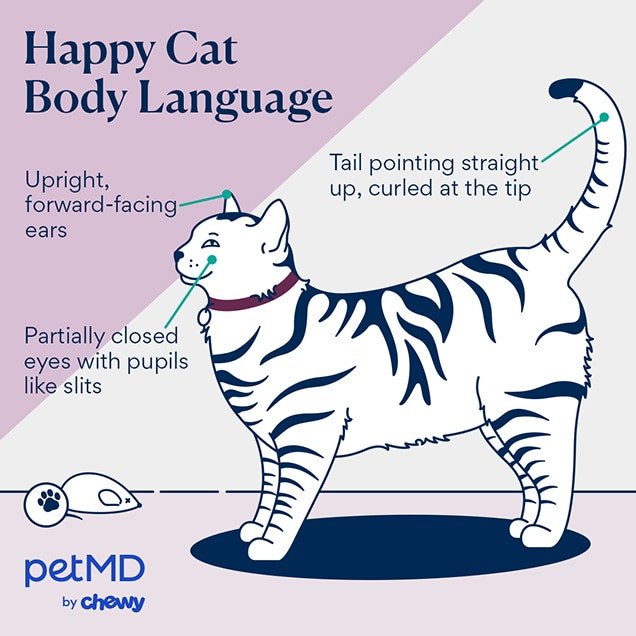 illustration depicting what a happy cat
illustration depicting what a happy cat
When your cat is in a state of bliss, their body language radiates relaxation. A happy cat often exhibits a loose and relaxed posture, limbs and tail outstretched when lounging. If your feline friend rolls onto their back, exposing their belly, it’s usually a sign of feeling safe and secure in their environment – though it’s worth noting this isn’t always an invitation for a belly rub! A content cat might also seek closeness, cuddling up to you, or express their affection by kneading you with their paws, a behavior rooted in kittenhood comfort.
Eyes: The eyes of a happy cat can be round and soft or gently narrowed, often appearing partially closed in contentment. Their pupils will typically be narrow slits in normal lighting. One of the most endearing signs of feline affection is the slow blink. When a cat blinks slowly at you, it’s a gesture of trust and love, a gentle “I love you” in cat language. Responding with a slow blink back is a wonderful way to reciprocate their affection.
Ears: A happy cat’s ears are typically held upright and facing forward, alert yet relaxed, indicating they are comfortable and at ease.
Tail: The tail is a fantastic indicator of a cat’s mood. A tail held straight up, often with a gentle curl at the tip like a question mark, is a reliable sign of a happy, confident, and approachable cat. This “upright tail” posture is often used as a friendly greeting.
Happy cats may also vocalize their contentment through purring, a low rumble of pleasure. They might meow to greet you or to solicit attention, food, or play. A delightful sound known as a trill, a high-pitched purr-like vocalization, is another friendly greeting, signaling sociability and happiness.
Playful Cat Body Language: Ready to Pounce
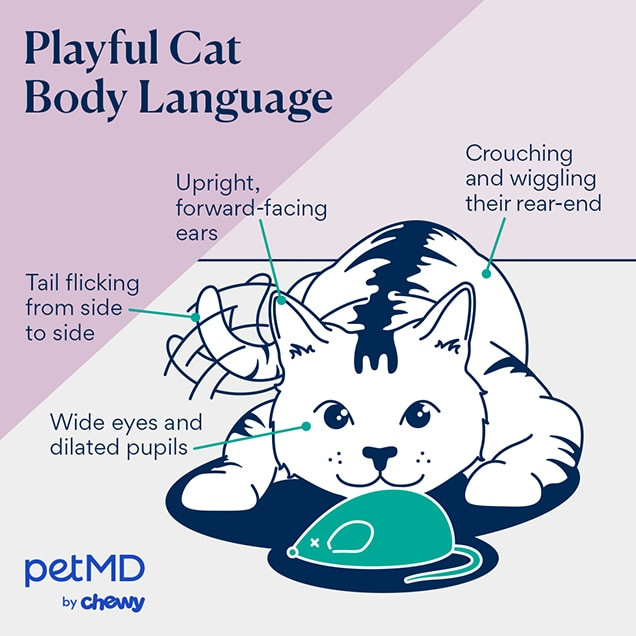 illustration depicting a playful cat
illustration depicting a playful cat
Cats are natural hunters, and their playful behavior often mirrors their predatory instincts. When playtime is on their mind, cats will engage in hunting-like actions. This might involve crouching low to the ground, sometimes with their rear end wiggling in anticipation before a pounce, and then chasing, batting, or grabbing onto a favorite toy. This type of play is essential for both physical and mental stimulation.
Eyes: A playful cat’s eyes are wide and bright, full of excitement. Their pupils may dilate, becoming larger and rounder, reflecting their heightened state of arousal and focus on play.
Ears: Similar to a happy cat, a playful cat will hold their ears upright and forward, focused on the ‘prey’ (toy or target of their play).
Tail: The tail of a playful cat often flicks or twitches from side to side, particularly when they are focused on a toy or engaging in stalking behavior. This tail movement reflects their concentration and excitement as they prepare to “hunt.” However, it’s important to note that a flicking tail in other contexts, when not engaged in play or hunting, can indicate annoyance or irritation.
Providing your cat with regular playtime and interactive toys is crucial. It not only satisfies their natural instincts but also provides excellent physical and mental enrichment, contributing to their overall health and well-being. Recognizing playful body language is your cue to engage and strengthen your bond through interactive play.
Stressed Cat Body Language: Recognizing Discomfort
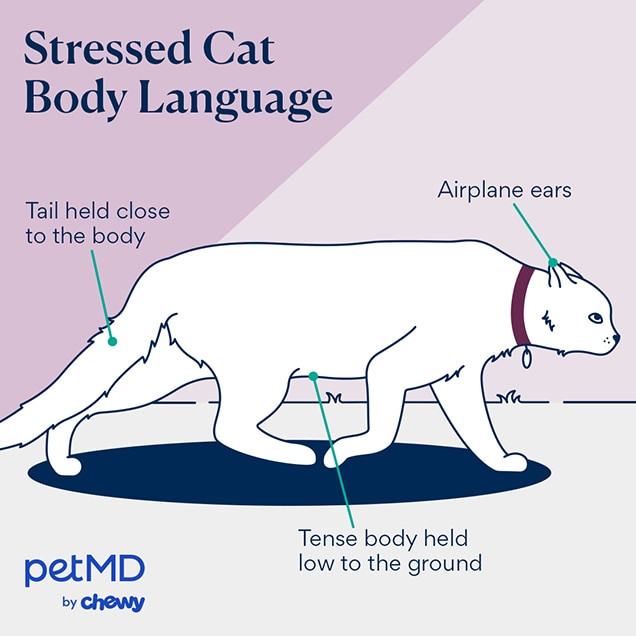 illustration depicting a stressed cat
illustration depicting a stressed cat
When a cat is feeling stressed or anxious, their body language shifts to reflect their unease. A stressed cat often holds their body stiff and tense, sometimes crouched low to the ground. They may also exhibit what are known as displacement behaviors. These are normal cat behaviors, like lip licking, scratching, grooming, or yawning, but performed out of context as coping mechanisms for underlying stress. In more severe cases of stress, cats may resort to inappropriate elimination, urinating or defecating outside of their designated litter box.
Eyes: The eyes of a stressed cat can be variable. They might appear wide open with a startled look or narrowed and squinty, reflecting their discomfort.
Ears: Stressed cats often rotate their ears sideways, adopting an “airplane ears” posture, or angle them backward. Their whiskers might also be held further forward than usual, tense and projecting outwards.
Tail: A stressed cat may hold their tail very close to their body, sometimes tucked tightly between their legs for protection. Alternatively, they might thrash or thump their tail forcefully if they are feeling particularly stressed, agitated, or annoyed.
If you observe signs of stress in your cat, it’s important to try and identify the source of their anxiety and, if possible, remove or mitigate it. Consider recent changes in the environment, new people or pets, or loud noises. If you suspect your own actions are causing stress, immediately stop the behavior and reassess the situation from your cat’s perspective. Providing a calm and predictable environment is key to reducing feline stress.
Fearful Cat Body Language: Reacting to Threat
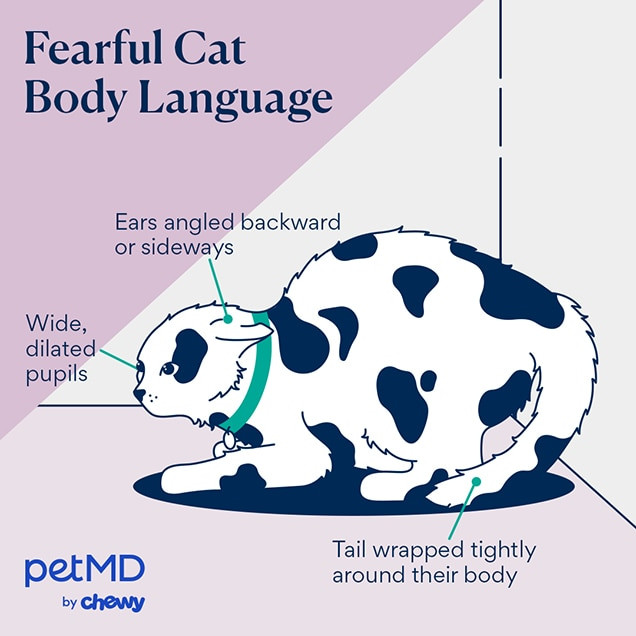 illustration of a scared cat
illustration of a scared cat
Cats, while predators themselves, are also prey animals. When they perceive a threat, their instinct is to protect themselves. A fearful cat will often try to make themselves appear smaller and less conspicuous. They may crouch very low to the ground, flattening their body and trying to minimize their profile.
Eyes: Fear triggers the fight-or-flight response, and a fearful cat’s eyes will reflect this. Their eyes will widen, and their pupils will dilate significantly, becoming large and round to take in as much visual information as possible.
Ears: The ears of a fearful cat are a clear indicator of their emotional state. They will be angled backward or sideways, and the further back and flatter against their head the ears are pinned, the more intensely terrified the cat is. Their whiskers may also be pulled back flat against their face, minimizing their presence.
Tail: A fearful cat will often wrap their tail tightly around their body or tuck it underneath them, seeking to protect this vulnerable part of their anatomy.
When fear escalates to a feeling of threat, cats may employ vocalizations as warning signals. Growling and hissing are common defensive sounds intended to deter the perceived danger. Hissing is largely an involuntary reflex when a cat is startled or frightened. If the threat persists or intensifies, a cat’s fear can escalate to a loud, drawn-out yowl followed by a shriek, indicating they are on the verge of defending themselves aggressively.
If you recognize fearful body language in your cat, the immediate priority is to remove the perceived threat. Never attempt to approach or pick up a growling or hissing cat, as this is likely to escalate their fear and trigger defensive aggression. Ensure your cat has access to safe spaces where they can retreat and feel secure. Providing plenty of hiding spots, such as covered beds and elevated perches, allows them to escape perceived dangers and regain a sense of control and safety.
Aggressive Cat Body Language: Defense Mode Activated
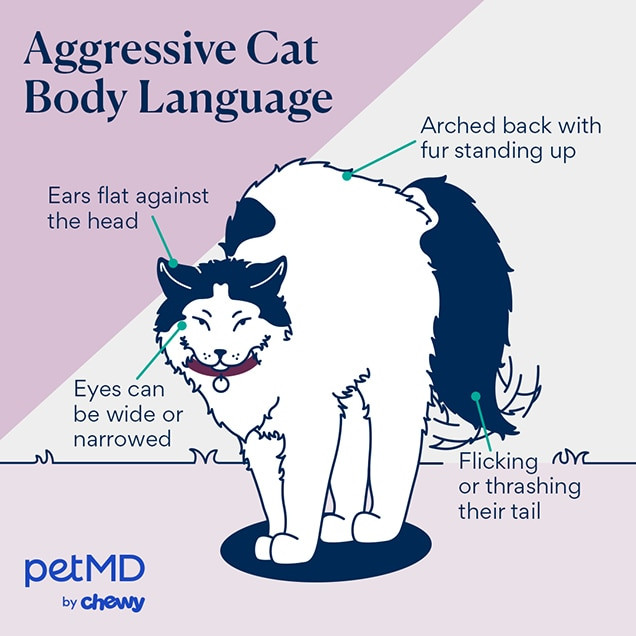 illustration of a cat
illustration of a cat
In situations where a cat feels cornered or believes they are in imminent danger, aggression may become their only perceived option for self-preservation. An aggressive cat aims to appear as large and intimidating as possible. They may arch their back, raising their spine, and their fur will stand on end, a phenomenon called piloerection, an involuntary reaction to fear and arousal.
Eyes: The eyes of an aggressive cat can present in two ways: they may be widened with enlarged pupils, staring intensely to maintain focus on the perceived threat, or they might be narrowed, focusing intently on their target just before an attack.
Ears: An aggressive cat’s ears will be turned backward or flattened tightly against their head, protecting them during a potential confrontation. Their whiskers might be flattened against their cheeks or pushed forward, depending on the cat’s specific aggressive posture.
Tail: The tail of an aggressive cat is often flicking or thrashing violently, reflecting their heightened state of agitation and readiness to defend themselves.
Cats often attempt to avoid physical aggression by initially resorting to warning signals like growling and hissing. Spitting, a sudden and explosive burst of air and noise, often accompanied by a lunge or swat, is another escalation in their warning behavior. Like hissing, spitting is an involuntary reaction to extreme fear or aggression.
It’s crucial to recognize that signs of aggression in cats are not expressions of malice or vindictiveness; they are indicators of panic and fear. If you observe aggressive body language, the most important action is to immediately remove the perceived threat and give the cat ample space to de-escalate. Understanding that aggression stems from fear allows for a more compassionate and effective response.
Sick or Painful Cat Body Language: Subtle Signs of Illness
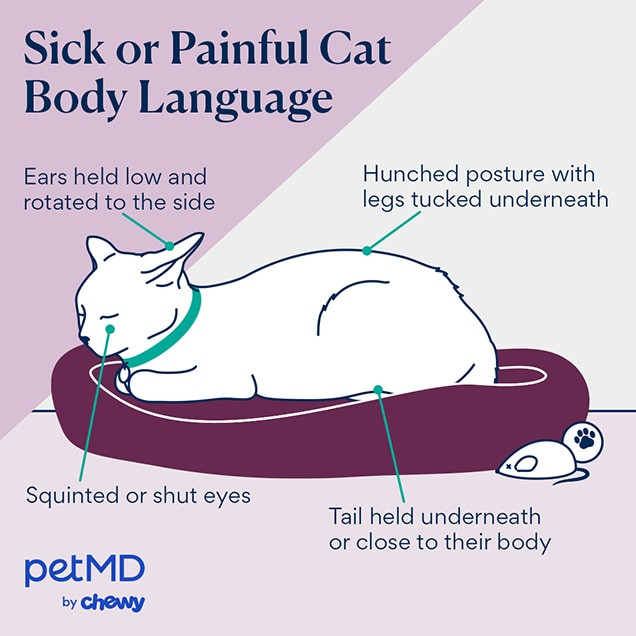 illustration of a cat
illustration of a cat
Cat body language provides invaluable insights not only into their emotional state but also their physical well-being. Changes in body language can be early indicators that a cat is sick or experiencing pain. Cats are masters at masking illness, a survival instinct to avoid appearing vulnerable. Therefore, subtle shifts in their usual demeanor and posture can be crucial clues that something is amiss.
When a cat is in pain or feeling unwell, they may adopt a hunched posture, with their body curved and legs tucked underneath them. Their overall body posture may appear tense and rigid.
Eyes: A sick or painful cat’s eyes may be squinted or held partially or fully shut, reflecting their discomfort. Their eyes may appear dull, dazed, or glassy, lacking their usual bright alertness. Sometimes, the cat’s third eyelid, the pinkish-white tissue in the inner corner of their eyes, may become visibly prominent, another sign of potential illness or pain.
Ears: Similar to stressed or fearful cats, a sick or painful cat may hold their ears low or rotated to the sides, indicating they are not feeling well.
Tail: The tail of a sick or painful cat might be held tucked underneath their body or wrapped closely around themselves, a protective posture indicating vulnerability and discomfort.
Interestingly, cats may purr not only when content but also when experiencing pain or illness, a self-soothing mechanism. An increase in meowing or yowling, especially if persistent or unusual, can also signal emotional or physical distress.
If you observe any of these changes in your cat’s body language, especially if accompanied by other behavioral changes such as hiding, aggression, decreased energy, or alterations in appetite, grooming habits, or sociability, it’s essential to seek veterinary attention promptly. Early detection and intervention are crucial for maintaining your cat’s health and well-being.
Understanding cat body language is an invaluable skill for any cat owner. By learning to interpret these subtle yet expressive cues, you can build a stronger, more empathetic relationship with your feline companion, becoming a more attuned and responsible cat parent, and ensuring their overall happiness and well-being.

